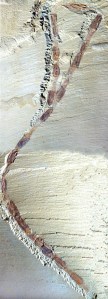 One of the most remarkable fossil sites in the world is located in Chengjiang in China, where exquisitely-preserved fossils record the early diversification of animal life. The 525 million year old mudstone deposits in the hills and lakes of Yunnan Province, South China are so fine that they have preserved not only the shells and carapaces of Cambrian animals, but also the detail of their soft tissue. In recognition, the site was added to the World Heritage list by UNESCO in 2012.
One of the most remarkable fossil sites in the world is located in Chengjiang in China, where exquisitely-preserved fossils record the early diversification of animal life. The 525 million year old mudstone deposits in the hills and lakes of Yunnan Province, South China are so fine that they have preserved not only the shells and carapaces of Cambrian animals, but also the detail of their soft tissue. In recognition, the site was added to the World Heritage list by UNESCO in 2012.


Professor Derek Siveter, a senior research fellow at the Museum, has been studying this material for a number of years, authoring a book – The fossils of Chengjiang, China: The flowering of early animal life – in 2004. But the rate of discovery of new fossils over the last decade has led to a wealth of new material to be documented.
So Derek recently headed back to the University of Yunnan for a two-week visit, where he began work on a revised edition of the book. Much of the documentation of these important fossils is currently in Chinese, so the new edition will bring the material to English-speaking researchers and fossils enthusiasts too. It introduces both the professional and the amateur palaeontologist – and all those fascinated by evolutionary biology – to the aesthetic and scientific quality of the Chengjiang fossils, many of which represent the origins of animal groups that have sustained global biodiversity to the present day.
Scott Billings – Public engagement officer



Published by